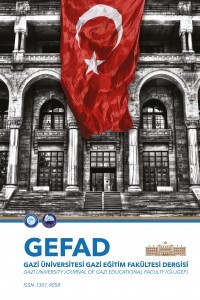Lise 1 Biyoloji Dersi Alan Öğrencilerin Canlıların Çeşitliliği ve Sınıflandırılmasıyla ilgili Kavram Yanılgılarının Belirlenmesi ve Kavram Haritası Yardımıyla Değiştirilmesi
İlk ve orta öğrenim fen bilimleri eğitiminde, öğrencilerin sahip oldukları kavram yanılgılarını değiştirmek için öğretmenler ve fen bilimleri eğitimcileri tarafından farklı öğretim yöntemleri kullanılmaktadır. Kavram yanılgılarını değiştirmek kullanılan en yaygın olan yöntemlerden biri de kavram haritalarıdır. Bu çalışmanın amacı Lise 1. sınıf biyoloji dersi alan öğrencilerin Canlıların çeşitliliği ve sınıflandırılması hakkındaki kavram yanılgılarını değiştirmektir. Bu çalışma biyoloji dersi alan 92 Lise 1(9. sınıf) öğrencisiyle yapılmıştır. Kavram haritaları ve geleneksel biyoloji öğretimi deney ve kontrol gruplarına uygulanmıştır. Altı hafta alan bu çalışma sürecinde Canlıların Çeşitliliği ve Sınıflandırılmasıyla ilgili başarı testi ön ve son test olarak her iki öğretim metodunu karşılaştırmak için kullanılmıştır. Ayrıca Kavram HariSonuçta biyoloji öğretiminde kavram haritalarıyla öğretim ve öğrenme hem öğrencilerin anlamlı bir şekilde başarılarını artırmış hem de tutumlarını olumlu bir şekilde değiştirmiştir. In the elementary and secondary science education, different instruction methods are used by science teachers in order to change misconceptions held by students. One of the common methods used to change misconceptions is the concept maps. The purpose of this study is to change the misconceptions in diversity of living organisms and their classification held by the 9th year high school students in biology courses. This study has been carried out by in two 92 students of 9th year high school biology classes. The concept maps and traditional biology instruction have been applied to the experimental and control groups. Throughout this study which took six weeks to compare the two instruction methods, the achievement test of classification aKavram yanılgıları, Canlıların sınıflandırılması, biyoloji ve fen bilgisi eğitimiMisconceptions, Classification of Living Things, Biology and Science Education Tam Metin
Anahtar Kelimeler:
Kavram yanılgıları, Canlıların sınıflandırılması, biyoloji ve fen bilgisi eğitimi
Using Concept Maps Changing the Misconceptions of the First Year High School Students in Biology Courses in Classification of Living Things and Their Diversity
Sonuçta biyoloji öğretiminde kavram haritalarıyla öğretim ve öğrenme hem öğrencilerin anlamlı bir şekilde başarılarını artırmış hem de tutumlarını olumlu bir şekilde değiştirmiştir. In the elementary and secondary science education, different instruction methods are used by science teachers in order to change misconceptions held by students. One of the common methods used to change misconceptions is the concept maps. The purpose of this study is to change the misconceptions in diversity of living organisms and their classification held by the 9th year high school students in biology courses. This study has been carried out by in two 92 students of 9th year high school biology classes. The concept maps and traditional biology instruction have been applied to the experimental and control groups. Throughout this study which took six weeks to compare the two instruction methods, the achievement test of classification aKavram yanılgıları, Canlıların sınıflandırılması, biyoloji ve fen bilgisi eğitimiMisconceptions, Classification of Living Things, Biology and Science Education Tam Metin
___
- Amir, R., and Tamir, P., (1995). Proposition generating task (PGT): A measure of meaningful learning and conceptual change, Journal of Biological Education, 29(2), 111-119.
- Arnaudin, M., V., and Mintzes, J., J., (1985). Students’ alternative conceptions of the human circulatory systems: A cross age study, Science Education, 69(5), 721-733.
- Bell, B., F., (1981). When is an animal, not an animal, Journal of Biological Education, 15(3), 213-218.
- Bloom, J., W., (1990). Contexts of meaning: young children’s understanding of biological phenomena, International Journal of Science Education, 12(5), 549-561.
- Ian, M. and Kichin, (2000). Concept mapping in biology, Journal of Biological Education, 34(2), 61-68.
- Kellert, S., R., (1985). Attitudes toward animals: Age related development among children, Journal of Environmental Education, 26(3), 215-223.
- Kinchin, I., M., David, B., H., and Adams, A., (2000). How a qualitative approach to concept map analysis can used to aid learning by illustrating patterns of conceptual development, Educational Research, 42(1), 43-57.
- Lord, T., R., (1999). A comparison between traditional and constructivist teaching in environmental science, Journal of Environmental Education, 30(3), 22-28.
- Pines, A., and West, L., (1986). Conceptual understanding and science learning: An interpretation of research within a source of knowledge framework, Science Education, 70(5), 583-604.
- Smith, K., M., and Dwyer, F., M., (1995). The effect of concept mapping strategies in facilitating student achievement, International Journal of Instructional Media, 22(1), 25-32.
- Strike, K., A., and Posner, G., J., (1982). Conceptual change and science teaching, European Journal of science Education, 4, 231-240.
- Treagust, D., F., (1988). Development and use of diagnostic tests to evaluate students “misconceptions in science”, International Journal of Science Education, 10(2), 159-169.
- Trowbridge, J., E., and Mintzes, J., J., (1985). Students’s alternative conceptions of animals and classification: A cross-age study, Journal of Research in Science Teaching, 25(7), 547-571.
- Uzuntiyaki, E., and Geban, O, (1999), İlköğretim 8. Sınıf çözelti konusunun öğretiminde kavramsal değişim metinleri ve kavram haritalarının kullanımı, III. Ulusal Fen Bilimleri Egitimi Sempozyumu Bildiri Kitabi, s:142-152.
- ISSN: 1301-9058
- Yayın Aralığı: Yılda 3 Sayı
- Başlangıç: 1985
- Yayıncı: Gazi Üniversitesi
Sayıdaki Diğer Makaleler
Öğrencilerin Sosyal Sorumluluklarının Geliştirilmesinde Öğretmenlerin Rolü
Müzik Öğretmenliği Mesleği Gerekleri Doğrultusunda Bir Armoni Eğitimi
Lütfullah TÜRKMEN, Osman ÇARDAK, Musa DIKMENLI
Yahya Akengin in Şiirlerinde Fikir Unsurları
Teknik Öğretmen Yetiştirme Sorunu Ve Teknik Eğitim Fakültelerinin Geleceği
20. Yüzyılın Birinci Yarısında Alman Müzik Eğitimini Etkileyen Başlıca Oluşumlar Ve Okul Müzik Dersi
Üniversite Öğretim Elemanlarının Boş Zaman Alışkanlıklarını Değerlendirmeleri Üzerine Bir Araştırma
Elektrik ve Manyetizma Konularında Anlaşılması Zor Kavramlar İçin Model Geliştirilmesi
